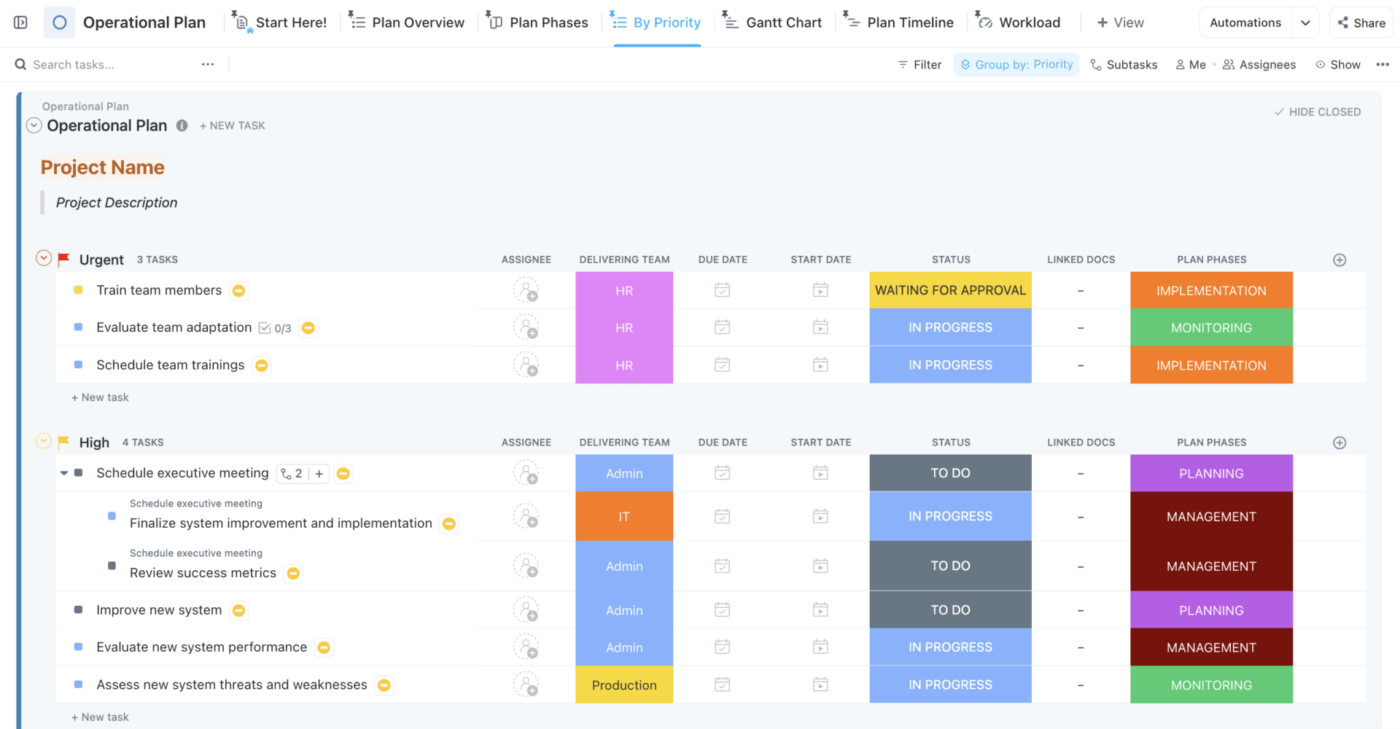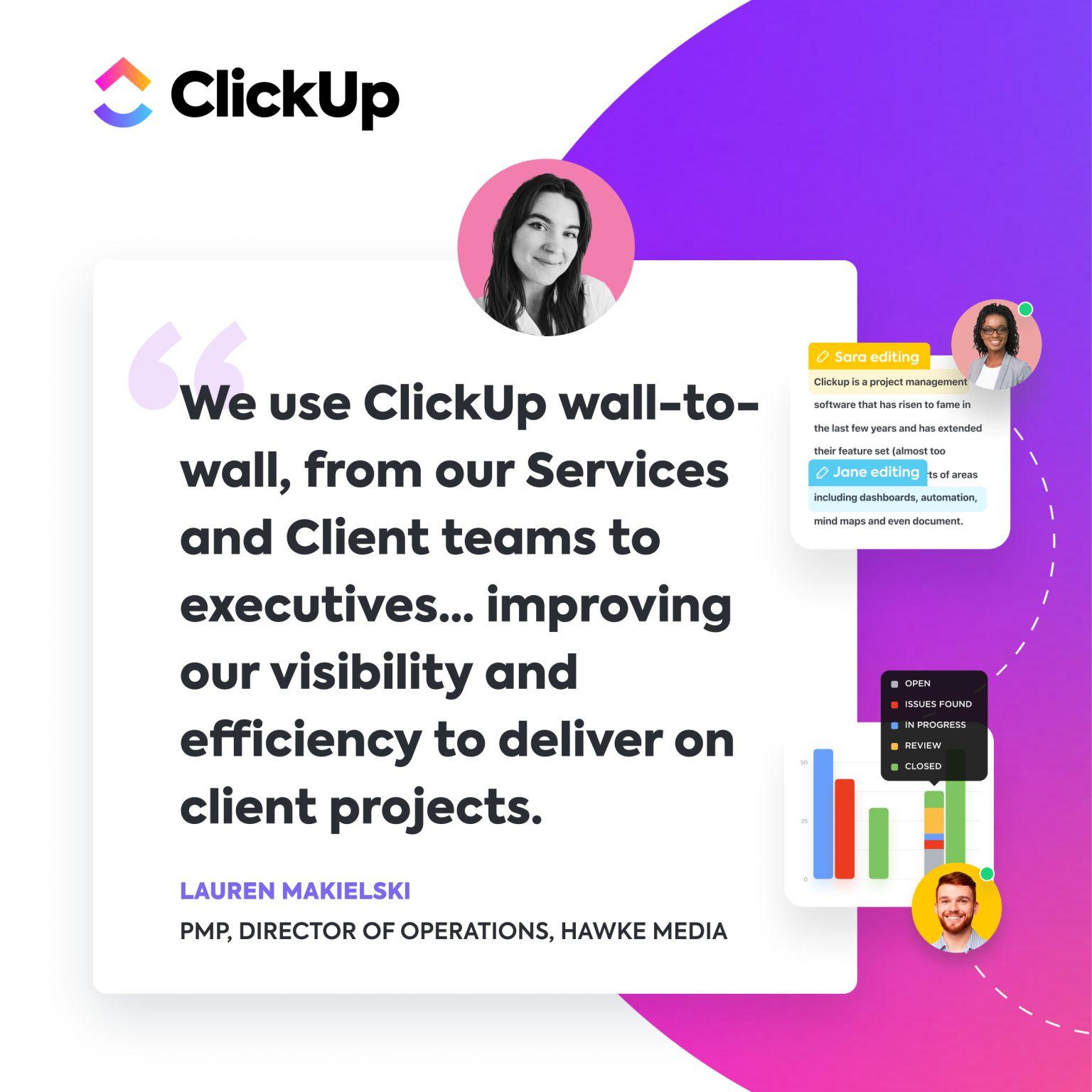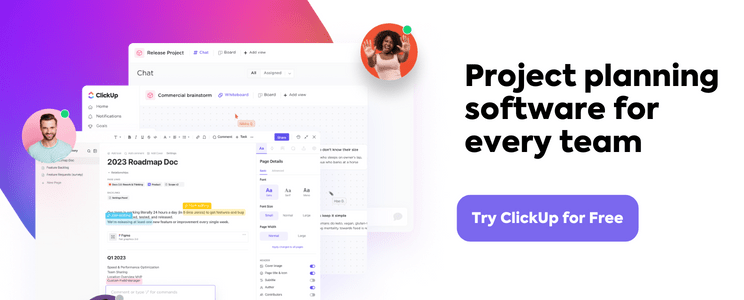لماذا تتماشى بعض الشركات مع الأولويات الاستراتيجية وتعمل بأقصى درجات الكفاءة بينما البعض الآخر لديه مخزون من المشاريع غير الناجحة؟
الإجابة المختصرة هي أن العمر الافتراضي لاستراتيجية العمليات يتوقف على التنفيذ اليومي.
في استطلاع عالمي أجرته شركة ClickUp في عام 2023 على مئات من قادة الأعمال, 35% من المستجيبين قالوا إن الكفاءة التشغيلية هي محور تركيزهم الرئيسي لنجاح الأعمال. هذه دعوة إلى العمل من أجل أبطال النتائج، وهم المتخصصون في إدارة العمليات الذين ينسقون الموارد والعمليات والأشخاص لتحقيق التميز التشغيلي. ✨
إن السؤال الأساسي الذي يجب طرحه قبل اتخاذ أي خطوات هو سؤال ذو شقين: ما هي استراتيجيات مؤسستك اللوجستية والثقافية ذات الصلة، وكيف تحافظ على أفضل شراكة بين جميع مستويات القيادة والفرق لتحقيق النجاح؟
لا يقتصر بناء الاستراتيجيات على حل المشاكل فقط. بل يجب أن تستفيد من قدرات التكنولوجيا وبناء مكان عمل يزيل الآراء القائمة على الخوف من تجربة أفكار جديدة. وهذا النوع من الابتكار هو وقود لكل من العمل الاستراتيجي و الإنتاج.

ما هي استراتيجية العمليات؟
استراتيجية العمليات هي الخطة القابلة للتنفيذ التي توجه كيفية إدارة الشركة لعملياتها ومواردها بما يتماشى مع أهدافها التنظيمية الشاملة. تتضمن هذه العمليات إنتاج وتسليم المنتجات أو الخدمات التي تقدمها الشركة.
وبعيدًا عن المصطلحات، هناك مفهوم يشكل ثقافة مكان العمل والإنتاجية وأهداف العمل. تقوم أي شركة - سواء كانت صغيرة أو متوسطة أو كبيرة - بذلك لتناسب ما تقوم به، وأين تقوم به، وكيف تريد أن تكون مختلفة عن غيرها في مجالها.
بينما يمكن أن يُنظر إليه على أنه تداخل مع التخطيط الاستراتيجي هناك فرق يجب الانتباه إليه أثناء استكشافنا لهذا الدليل: يحدد التخطيط الاستراتيجي الرؤية والتوجه العام للمنظمة، وغالبًا ما يتم ذلك سنويًا أو نصف سنوي. تصف الأهداف الرئيسية للعملية العمليات وسير العمل التي سيتم استخدامها لإكمال العمل. ⚙️
دعونا نلقي نظرة على أمثلة استراتيجية العمليات لمجالات وظيفية محددة داخل المنظمة:
أنواع استراتيجيات العمليات للتحسين ومكاسب الكفاءة والابتكار ### أنواع استراتيجيات العمليات للتحسين ومكاسب الكفاءة والابتكار
تفصيل أمثلة لاستراتيجيات العمليات لتحقيق استراتيجية العمل الشاملة _
| نوع الإستراتيجية | الإنجازات |
|---|---|
| استراتيجيات الكفاءة الأساسية | تسخير نقاط القوة الفريدة للشركة لاكتساب ميزة تنافسية، مع التركيز على المهارات أو التقنيات المتميزة التي تحدد نجاح الأعمال |
| استراتيجيات الريادة من حيث التكلفة | تهدف إلى أن تكون الشركة الأقل تكلفة في الصناعة، حيث تقدم منتجات أو خدمات عالية الجودة بأسعار أقل من المنافسين |
| استراتيجيات تعتمد على العميل | دمج التكنولوجيا لتحقيق الكفاءة والمرونة وتجربة العملاء من خلال اعتماد الحوسبة السحابية وتحليلات البيانات والأتمتة وأدوات إعداد التقارير الرقمية |
| التمييز/التنافسية الاستراتيجيات | تمييز المنتج أو الخدمة، بهدف تحقيق الجودة المتصورة والميزات الفريدة وولاء العملاء لتبرير التسعير المتميز |
| استراتيجيات التحول الرقمي | دفع عجلة النمو من خلال التحسين المستمر، وتعزيز الإبداع، والاستثمار في البحث والتطوير للحفاظ على التنافسية والملاءمة |
| استراتيجيات إشراك الموظفين | رعاية القوى العاملة المتحمسة والملتزمة من خلال تعزيز الثقافة الإيجابية وتمكين النمو وإشراك الموظفين في اتخاذ القرارات |
| استراتيجيات عمليات المخزون | تشمل مختلف جوانب إدارة المخزون (المشتريات والتخزين والتوزيع والتحسين)، بحيث تتوفر الكمية المناسبة من السلع في الوقت والمكان والتكلفة المناسبين |
| استراتيجيات التميز التشغيلي | تحسين العمليات من أجل تحقيق الكفاءة والفعالية من حيث التكلفة والجودة، مدفوعة بأساليب التحسين المستمر مثل Lean Six Sigma |
| استراتيجيات الاستعانة بمصادر خارجية | التعاقد مع مزودي خدمات خارجيين، مما يقلل من التكاليف ويتيح للفرق الداخلية التركيز على أنشطة الأعمال الأساسية |
| استراتيجيات المنتجات أو الخدمات | التركيز على ابتكار منتجات أو خدمات تتجاوز التوقعات من خلال تحسين دورة الحياة بأكملها، بدءًا من المفهوم إلى الدعم بعد الإطلاق |
| استراتيجيات إدارة المخاطر | حماية الأعمال من خلال تحديد المخاطر المحتملة وتقييمها والتخفيف من حدتها من خلال تدابير الرقابة وخطط الطوارئ |
استراتيجيات العمليات هذه لا يستبعد بعضها بعضاً. وهذه أخبار جيدة! لا أحد يريد أن يكون مقيدًا باستراتيجية عمل واحدة. فالنهج المتكامل يتيح للمؤسسات تحسين عملياتها للمنتجات/الخدمات وشرائح العملاء والأسواق المختلفة. 🎯
عندما تستثمر المؤسسة في استراتيجية العمليات وتنفيذها، فإنها تستثمر في إنتاجية الموظفين. فمع وجود خط رؤية مباشر لـ لماذا و كيف وراء مهامهم، لا يضطرون إلى التنقل في مستويات عالية من الغموض.
وبدلاً من ذلك، يتم إعدادهم بتعليمات واضحة لإكمال المهام الصحيحة.
إذا كنت متحمسًا لبدء التنقيب عن العمليات وتحديد الخطوط العريضة لـ الأهداف التشغيلية الآن، قم بتحميل قالب الخطة التشغيلية من ClickUp . لقد حان الوقت لإزالة الفوضى من مرآبك الذهني لإفساح المجال لمشاريع مثيرة وموجهة نحو النمو.
وجّه الدعوات إلى أقرب المتعاونين معك ونظّم ورشة عمل لهندسة الأنظمة، سواء في الوقت الفعلي أو بشكل غير متزامن! 📧

تنظيم مكونات خطة الاستراتيجية التشغيلية وتنفيذها ومراقبتها على قائمة ClickUp
حتى الآن، تعلمنا حتى الآن الأعمال الداخلية لاستراتيجية العمليات. لنرى ذلك عملياً.
كيفية بناء عناصر الاستراتيجية التشغيلية في خطط المشاريع
تم تصميم هذا الدليل الإرشادي المدمج لمدير العمليات لتنفيذ أفضل عمليات الأعمال الأساسية وسير العمل في خطط المشاريع.
إذن، لماذا هذا الدليل مضغوط؟ تنويه: نحن جميعًا في نفس المسرحية الهزلية ولكننا نقرأ نصوصًا مختلفة. في حين أن هناك نماذج أعمال وصناعات يمكننا تصنيف أنفسنا فيها، إلا أن كل شركة لديها مجموعة مختلفة من القيم الأساسية التي تعكس هدفها ومبادئها التوجيهية.
ولهذا السبب، فإن الأنظمة التي ستقرأها أدناه هي عوامل النجاح الرئيسية التي تحتاجها جميع الاستراتيجيات التشغيلية. يمكن للفرق أن تصل إلى ذروة أدائها من خلال وضع رؤية واحدة فقط في العمل!

الخطوة 1: تحديد ما الذي ستؤثر عليه استراتيجية العمليات أو تحويله
فكر في المنظور قصير الأجل (الأولويات التنافسية) والرؤية طويلة الأجل (المفاضلات).
يلبي التخطيط قصير المدى متطلبات العملاء الفورية، ويساعد على تخصيص الموارد في المكان والزمان المناسبين، ويوفر معايير لتقييم أداء الفريق.
يسمح التخطيط طويل الأجل للمؤسسات بالاستثمار في الحلول التكنولوجية الحديثة، وتوجيه فرص التوسع في السوق، وإعادة تصميم الخدمات اللوجستية.
يجب أن يكون للخطة التشغيلية نطاق أضيق وأن تهتم بالأنشطة اليومية والإجراءات اللازمة لتنفيذ الخطة الاستراتيجية . إن مفتاح الحصول على موافقة القيادة ودعمها هو توضيح قيمة خطتك وجدواها ومواءمتها.
وهنا يأتي دور المشاركة في إنشاء مؤشرات الأداء الرئيسية القابلة للقياس بسهولة مع فرق العمل وجميع مستويات القيادة أمر ضروري لتزويد كل عضو من أعضاء الفريق بشعور بالملكية في مهامهم. 🔑

تحليل استراتيجيات العمل على السبورة البيضاء ClickUp
الخطوة 2: تحديد وتأمين الموارد الأساسية اللازمة لتنفيذ الاستراتيجية بنجاح
يعد تشكيل فريق عمل لاستراتيجية العمليات جهدًا جماعيًا، خاصةً عند الشراكة مع فرق أخرى. سيساعد المتعاونون في مجالات التمويل والتسويق والموارد البشرية وغيرها في سد الثغرات المعرفية ودعم تعزيز الكفاءة وخفض التكاليف وتقديم قيمة أكبر.
كل قسم لديه مهام العمل المعتادة التي تحافظ على سير السفينة. إذا كانت استراتيجية العمليات الخاصة بك تتطلب جزءًا كبيرًا من الوقت، فيجب أن تكون هناك محادثات مع قادة الأقسام حول أفضل نهج لتقليل التعطيل. 💬
نظرًا لأن مديري العمليات لديهم دور معقد ومتعدد الأوجه، فإن هذه المناقشات هي لحظات تعليمية للتأثير على نتائج المشاريع.
هناك ثلاث أدوات قيّمة - تخطيط القدرات، وتخطيط الموارد، ورسم خرائط العمليات - ستزيل التخمين من هذه الخطوة.
- تخطيط القدرات يعطي رؤية واضحة حول ما إذا كان لديك ما يكفي من موارد الشركة لتلبية متطلبات احتياجات المشروع
- تخطيط الموارد يجيب على السؤال: ما هي المشاريع التي تعمل عليها مواردنا حالياً؟
- تخطيط تصميم العمليات يحدد تسلسل الأحداث، والمهام، والأنشطة المتضمنة في عملية تجارية
 ### الخطوة 3: المشاركة في وضع خطة عمل لتأمين تدفق المواد والمعلومات والموارد
### الخطوة 3: المشاركة في وضع خطة عمل لتأمين تدفق المواد والمعلومات والموارد
ستستغرق خطة العمل هذه عدة جولات للانتهاء منها، لكنها لن تكون مكتملة حتى ذلك الحين لأن الأولويات قد تتطور مع تغير الظروف. إن أفضل ضمانة للشفافية في أي تحول في الاستراتيجية هو وجود مصدر واحد للحقيقة لإعادة النظر وإجراء التعديلات الجزئية. ⚖️
ستختلف محتويات خطة العمل الخاصة بك بناءً على نموذج أعمال شركتك وعملياتها التشغيلية. كحد أدنى، يجب أن تتضمن محتويات وثيقة خطة العمل الخاصة بك ما يلي:
تفصيلاً للأقسام اللازمة لوثيقة خطة الاستراتيجية التشغيلية
| القسم | المحتوى | |
|---|---|---|
| العنوان | ابدأ باسم لا يُنسى يعكس تأثير الاستراتيجية التشغيلية أو محور تركيزها | |
| مقدمة | تقديم لمحة موجزة عن الاستراتيجية التشغيلية وأهدافها وسبب ارتباطها بأهداف الاستراتيجية المؤسسية | |
| ملخص تنفيذي | لخص النقاط الرئيسية لخطة العمل، بما في ذلك الأهداف ذات الأولوية، وأصحاب المهام/المساهمين في المهام، والجداول الزمنية، والنتائج المتوقعة | |
| المهام والمبادرات رفيعة المستوى | تفصيل حجم ونطاق المهام أو المبادرات المطلوبة للتنفيذ | |
| الفرق المسؤولة | تحديد رؤساء الأقسام/المساهمين الأفراد الذين سيكونون مسؤولين عن أي تحديثات ومراجعات وموافقات على اتصالات المشروع | |
| الجداول الزمنية والمعالم الرئيسية | حدد الجداول الزمنية المحددة للأنشطة الرئيسية والمخرجات ونقاط التحقق من مراقبة الجودة التي تشير إلى التقدم الفعلي | |
| التبعيات | تسليط الضوء على المهام التي يجب إكمالها قبل أن تبدأ المهام الأخرى ومعالجة كيفية إدارة التبعيات لمنع التأخير | |
| تخصيص الموارد | تفاصيل تخصيص الموارد، بما في ذلك الميزانية والموظفين والتكنولوجيا والمواد. اذكر أي قيود على الموارد، إن وجدت! | |
| تقييم المخاطر والتخفيف من حدتها | تحديد المخاطر والتحديات المحتملة مع خطط الطوارئ | |
| التواصل وإشراك أصحاب المصلحة | وصف خطة التواصل لإبقاء جميع أصحاب المصلحة على اطلاع ومستوى مشاركة أصحاب المصلحة | |
| المرفقات | تضمين أي وثائق داعمة وأبحاث ومشاريع ذات صلة | |
| الإبلاغ والمراقبة | حدد المقاييس ومؤشرات الأداء الرئيسية التي سيتم استخدامها لقياس التقدم والنجاح | |
| الميزانية والتخطيط المالي | أضف الموارد المالية المخصصة لكل مهمة أو مبادرة |
إذا شعرت أن الكون يشعر بالملل ويبدأ في تنفيذ الأمور من تلقاء نفسه لأنك استغرقت أكثر من أسبوع لصياغة خطة عمل، جرّب ClickUp AI . لقد قمنا بتغطيتك بأكثر من 100 أداة تستخدم مطالبات قائمة على البحث مصممة خصيصًا لأدوار محددة! 🤖

استخدام المطالبات مع ClickUp AI لإنشاء المستندات بسرعة
الخطوة 4: الاستفادة من التكنولوجيا وأن تكون القوة الدافعة وراء تنفيذ الاستراتيجية
هل تشعر الفرق بالراحة في مشاركة أفكارهم ومخاوفهم وملاحظاتهم؟ هل هناك زيادة في المشاريع المتأخرة بسبب نقص المساءلة؟ هل يتساءل أعضاء الفريق "ماذا يجب أن أفعل اليوم؟
إن مهاراتك في القيادة والتواصل وحل المشكلات ضرورية لنجاح استراتيجية العمليات. نظرًا لأنك تعمل بين فرق مختلفة، سيتعين عليك تنظيم المعلومات المتنوعة التي تأتيك من قنوات مختلفة. 👨💻
ستحتاج إلى إدارة المهام حاوية لإعداد الجميع للنجاح وتوصيل التوقعات لتنفيذ المشاريع. إذا كنت تعتقد أن خطة العمل التي كتبتها في الخطوة 3 ستكون "جيدة بما فيه الكفاية"، ففكر في هذا:
إدارة المهام من خلال خطة عمل ثابتة يمكن أن تطغى على الفرق الكبيرة أو المشاريع المعقدة. هناك الكثير من الضوضاء والفوضى التي يمكن أن تتصفحها يوميًا. مهمة مخصصة و برنامج إدارة المشاريع يُمهد الطريق للإنتاجية الفردية والجماعية على نطاق واسع.
لا يمكن للنماذج اليدوية أن تواكب متطلبات القوى العاملة الرشيقة، كما أن المرونة أمر غير قابل للتفاوض في سوق اليوم حيث حالات استخدام الذكاء الاصطناعي المصممة خصيصًا للصناعة تستمر في النمو. يجب أن تنفق وقتك واهتمامك على المهام والأنشطة ذات القيمة العالية التي تقرب الفرق من تحقيق أهدافها.

إنشاء أنظمة فعالة لتتبع جميع المهام والأنشطة في ClickUp
خذ قسطًا سريعًا من الراحة، ثم قم بتنزيل قالب خطة العمل اليومية من ClickUp . يحتوي هذا القالب على جميع المكونات اللازمة لتنظيم مهام المهام والمراحل الرئيسية والمواعيد النهائية والمساهمين.
كمستخدمي ClickUp، سيكون لدى فرقك وأصحاب المصلحة جميع المهام والوثائق في متناول يدك لمراقبة التقدم عن كثب طوال مرحلة التنفيذ!
تحذير: التكاليف الخفية للاختصارات
من السهل التقليل من تأثير المهام الصغيرة التي تبدو عادية والتي تتراكم بمرور الوقت. ومع ذلك، يمكن أن تتحول هذه المهام "المدخرة لوقت لاحق" بسرعة إلى مشكلة كبيرة فريق العمل.
دعونا نلقي نظرة فاحصة على التكاليف الخفية للاختصارات:
- الدين الثقافي لمكان العمل: يشير الدين الثقافي في مكان العمل إلى العواقب السلبية لإهمال ثقافة الشركة وقيمها الأساسية، مثل انخفاض معنويات الموظفين، وارتفاع معدل دوران الموظفين، وانخفاض الإنتاجية، مما قد يضر بنجاحها على المدى الطويل
- الديون التقنية: ينشأ الدين التقني عندما يتم تطوير البرمجيات أو الحلول التقنية بسرعة أو بممارسات ترميز دون المستوى الأمثل لتلبية الاحتياجات الفورية
- ديون العمليات: تشير ديون العمليات إلى تراكم أوجه القصور وأوجه القصور في سير عمل المؤسسة وإجراءاتها بمرور الوقت
- الدين المعرفي: يحدث الدين المعرفي عندما تفشل المؤسسات في الاستثمار في الاستثمار المستمرالتعلم والتطوير المستمر لموظفيها

معالجة أي ديون هي جهد جماعي. فيما يلي بعض الطرق السريعة لسحبها من مجموعة أدوات الإنتاجية الخاصة بك ومعالجة المهام الصغيرة لأدنى حد من التأثير على مبادرات الإنتاج الخاصة بك:
- حدد أولويات المهام: حدد أولويات المهام باستخدام مصفوفة أيزنهاور (تأتي المهام العاجلة والهامة أولاً، تليها المهام الهامة وغير العاجلة)
- حظر جلسات العمل الجماعي: جدولةوقت التركيز كتل للمهام الصغيرة، وتجنب تعدد المهام لتقليل التشتت
- تجميع المهام على دفعات: تجميع المهام المتشابهة معًا ومعالجتها على دفعات لتقليل التبديل بين السياقات
- التفويض عند الاقتضاء: تفويض عناصر العمل والمهام التي يمكن للآخرين في فريقك التعامل معها
والآن، نعود إلى برنامجنا المجدول بانتظام! 🎬
الخطوة 5: وضع قوائم المراجعة وقواعد اتخاذ القرار للتحسين المستمر
مع الأخذ في الاعتبار أن المهام الروتينية الأخرى والمشاريع الخاصة تعمل في وقت واحد في عبء العمل الخاص بك، كيف تحافظ على زخم المجموعة في خطة العمليات؟
ابدأ بالأسئلة التي تساعد فريق إدارة العمليات على جمع البيانات وتحليلها بشكل منهجي على لوحة تحكم مركزية. سيقلل ذلك من العبء المعرفي ويسمح لأعضاء الفريق باتخاذ قرارات واثقة.
يمكن أن تكون قوائم المراجعة والقواعد هذه مفصلة بالقدر الذي تريده للاستخدام الداخلي. إذا كان ذلك يساعد على تقييم فائدتها الحقيقية، فقم بإجراء اختبار للمستفيدين. قم بإعطائها لقادة المشروع وأصحاب المصلحة والقيادة العليا للتأكد مما إذا كانوا يركزون على الأسئلة الصحيحة لتقييم التنفيذ اليومي أم لا. 📊
يمكنك الوصول إلى المهام والأنشطة المتعلقة بالمشروع من لوحة معلومات ClickUp
إذن، كيف يمكن لمديري العمليات تطبيق قوائم المراجعة وقواعد اتخاذ القرار على المستوى التكتيكي عندما يكونون في مواجهة جداول زمنية ضيقة؟
تقديم تجربة متسقة لفريقك من خلال روتين مجدول.
فيما يلي تفصيل لمهام الاستراتيجية التشغيلية على فترات زمنية محددة. هل هناك أي شيء تلاحظ أنه يمكن إضافته إلى جدولك الزمني الشخصي أو جدول فريقك؟ 🗓️
تفصيل للمهام اليومية والأسبوعية والشهرية لمحترفي إدارة العمليات لجدولة مهامهم في عبء العمل
التردد
بنود العمل
المهام اليومية
عقد موجز الاجتماعات اليومية أو التجمعات مع قادة المشروع لمناقشة التقدم المحرز والتحديات والأهداف لليوم/الأسبوع
معالجة المشاكل أو العوائق بجدية لمنعها من التفاقم إلى مشاكل أكثر أهمية
مراجعة التقدم اليومي والتحقق من وجود أي مشكلات أو اختناقات حرجة
مراقبة حالة مؤشرات الأداء الرئيسية (KPIs) باستمرار
المهام الأسبوعية
المسودة تقارير الحالة الأسبوعية إلى أصحاب المصلحة، مع تسليط الضوء على إنجازات المشروع والتحديات والمعالم القادمة
مراجعة تخصيص الموارد وتوزيع عبء العمل بحيث تكون الفرق متوازنة، ولا يتم تحميل أحد فوق طاقته
تقييم المخاطر الجديدة التي ظهرت خلال الأسبوع وتحديثها خطط تخفيف المخاطرجمع الملاحظات من أعضاء الفريق حول تقدم المهمة وتجاربهمتحليل التقدم المحرز مقابل الجداول الزمنية للمشروع والميزانيات والأهداف
المهام الشهرية
تدوين الملاحظات لتطوير خطة التحسين المستمر التي تحدد إجراءات محددة من أجل تحسين إدارة المشروع العمليات
استضافة مراجعات ما بعد المشروع أو المراجعات لتوثيق الدروس المستفادة من المشاريع المكتملة للرجوع إليها في المستقبل
النظر في تخطيط الموارد على المدى الطويل واحتياجات تطوير القوى العاملة بناءً على تطور محفظة المشاريع التحقق من أن المشاريع الجارية والمقبلة تتماشى مع الأهداف والأولويات الاستراتيجية العامة للمؤسسة
جمع وتحليل ملاحظات العملاء وأصحاب المصلحة حول نتائج المشروع وأدائه
تقييم ما إذا كانت المشاريع تسير في المسار الصحيح لتحقيق أهدافها وإجراء أي تعديلات ضرورية على خطط المشاريع مراجعة ميزانيات المشاريع والأداء المالي
ما التالي؟
بعد أن أصبح إطار استراتيجية العمليات المكتسبة حديثًا في متناول يدك، قم بتطبيقه في سياق عمليات شركتك وعملياتها. من إدارة سلسلة التوريد إلى البرمجيات وكل ما بينهما، ستحصل على الأدوات اللازمة لتنسيق أصعب استراتيجيات العمليات. 💪
وأخيراً، إذا كنت قد عانيت من تقدم عابر في مسؤولياتك، فقد يكون السبب في ذلك أنك لا تركز على الأشياء الصحيحة في الوقت المناسب. لا بأس - لا بل مسموح أن تطلب من زملائك أن يتحدوا ملاحظاتك عندما تتعثر.
اعتمد على الفريق في ClickUp كواحد من أقرانك، وتواصل معهم إذا كنت بحاجة إلى مساعدة للخروج من الباب الدوار للتنفيذ غير الناجح. تخطيط سعيد! ✍️
/ctaBtn/الأخضر https://clickup.com/plans/enterprise تواصل معنا /%ctaBtnTn/

